Can one modern appliance cut your energy bill and still keep groceries fresher?
This short guide helps readers choose the right stainless steel refrigerator for their kitchen, budget, and lifestyle. It outlines key features — from smart apps and energy modes to fingerprint-resistant finishes — so buyers can compare options with confidence.
The guide highlights notable products: LG models with ThinQ remote control, Smart Cooling and PrintProof finishes, and Samsung’s Bespoke Family Hub+ with a 32″ AI touchscreen, SmartThings Energy, and dual ice options. Many family-friendly units start at 24+ cu. ft., and select models include long compressor warranties.
Expect practical steps: how to measure for counter-depth vs full-depth units, check delivery paths, weigh ENERGY STAR and AI energy savings, and review warranty and customer rights. For a deeper walkthrough, see our stainless steel refrigerator guide.
How to choose a stainless steel refrigerator for your kitchen and lifestyle
A smart purchase begins by sizing capacity to weekly groceries and checking how doors will open in your space. Start by thinking of the unit as both a major appliance and a daily workspace. Measure, list habits, and prioritize features before you shop.
Match capacity (cu. ft.) to family size and food habits
Estimate weekly groceries and fresh produce volume. Many families find 24+ cu. ft. minimizes overcrowding and food waste.
Layout matters: french door designs place fresh items at eye level—ideal for frequent snacking or meal prep.
Measure for counter depth vs full depth before you shop
Counter depth models give a built-in look while keeping full-size capacity in some LG models. Full-depth units often hold more at similar widths.
- Record width, height, and depth—add space for ventilation and door swing.
- Check traffic flow so open doors or drawers don’t block walkways.
- Match freezer size and features to how you shop—bulk frozen goods need extra room.
- Refer to brand guides and ThinQ features to compare models that meet your capacity and connectivity needs.
Understanding sizes, depth, and fit in U.S. homes
Fit matters as much as features—get exact dimensions and plan the path into your home.
Counter-depth vs full-depth: Counter-depth models sit more flush with cabinets for a built-in look. Full-depth units extend farther to deliver more capacity — some push near 29 cu. ft. Choose based on whether curb appeal or maximum storage is the priority.
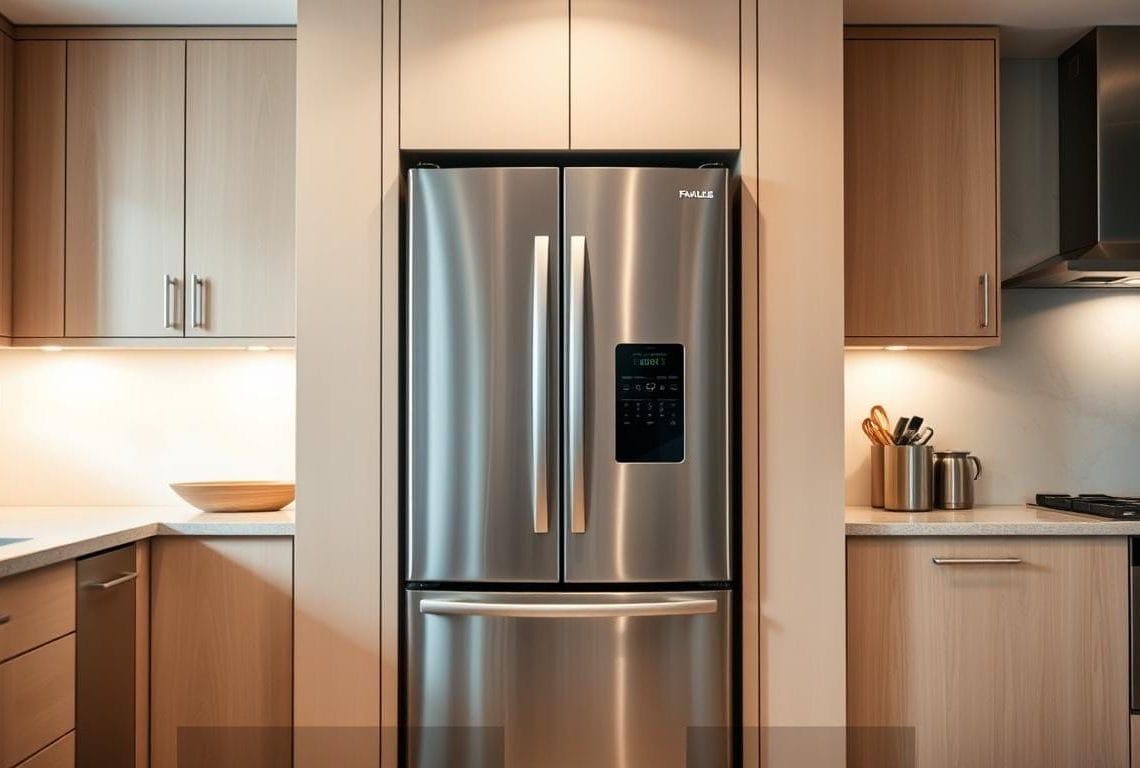
Key dimensions to check
Record width, height, and total depth with handles. Example: Samsung Bespoke 4-Door Flex measures 35.875″ W x 73″ H x 34.25″ D with handles.
Factor door swing — some models reach about 48.5″ when doors are open. Also note shipping dimensions (e.g., 38.25″ W x 78.625″ H x 36.25″ D) for delivery paths.
Delivery access and installation
- Measure doorways, hall turns, stair landings, and cabinet overhangs.
- Allow service for door removal if passages are tight; schedule professional installation.
- Verify power (115V/60Hz) and a water line for dispensers; test shutoff valves before delivery.
Keep your measurements and model number handy when consulting sales or scheduling installation. For a specific bottom-freezer option, see the stainless steel refrigerator with bottom freezer for detailed product dimensions and fit information.
Popular refrigerator configurations explained
Configuration choices shape how you store, reach, and serve food every day.
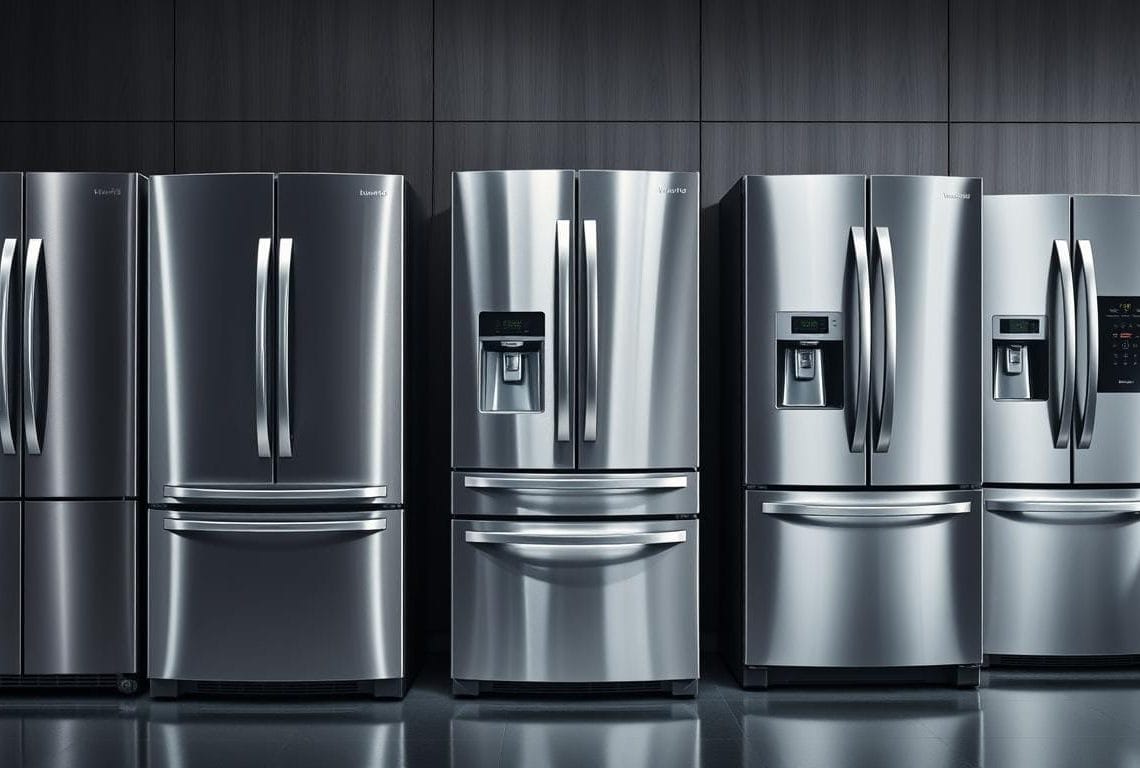
Choose a layout that fits your routine: some families need wide shelves for party trays, while others favor narrow door swing for tight kitchens. LG offers french door 3- and 4-door options, side-by-side, counter depth, top and bottom freezer designs, plus compact and garage-ready picks. Samsung’s Bespoke 4-Door Flex adds Triple Cooling and a FlexZone for convertible storage.
Common styles and what they do best
- French door: split upper doors and a bottom freezer—ideal for frequent fresh-food access and wide platter storage.
- 4-door / Flex: extra zones for beverages, deli, or soft-freeze settings—great for organization and mixed storage needs.
- Side-by-side: balanced fridge and freezer vertical access—good when freezer items should sit at eye level and space is narrow.
- Top / bottom freezer: top-freezer models are budget-friendly; bottom-freezer designs put fresh items at eye level and use pull-out drawers for bulk storage.
Depth and features to weigh: counter-depth styles trade a few cu. ft. for a built-in look; full-depth models maximize total capacity. Layer on features—dual ice, temperature-controlled drawers, internal dispensers—to match entertaining or daily needs.
For detailed comparisons and fit tips, see the stainless steel and black refrigerator guide when narrowing product choices and models for your kitchen style and storage plan.
Finish and fingerprint resistance: getting the steel look right
How a finish performs daily matters as much as how it looks. Choose a surface that cuts cleaning time, fits your kitchen lighting, and holds up to frequent use.

Print-proof coatings and smudge-resistant options
Modern coatings reduce fingerprints and preserve sheen. LG PrintProof resists smudges for easier cleanup. Samsung’s Bespoke line adds fingerprint-resistant faces and swap‑out panels in 11 colors.
Coordinating finishes and practical details
- Know your finishes: PrintProof reduces smudges while preserving the cool luster of stainless steel.
- Consider coordination: match textures and hues across appliances and cabinetry for a cohesive style.
- Evaluate maintenance: fingerprint-resistant doors cut daily wipe-down time in high-traffic kitchens.
- Explore customization: Bespoke panels let owners refresh color without replacing the whole unit—ideal for evolving style.
- Mind lighting: finishes reflect ambient light—test a sample next to counters and cabinets.
- Plan for handles: recessed versus bar handles change both look and how far the door projects into walkways.
- Confirm magnetism: some blends resist magnets—decide if you want magnet-ready surfaces for notes.
- Protect the surface: use non-abrasive cloths and manufacturer cleaners to avoid micro-scratches and sheen loss.
- Think long-term: durable finishes help resale appeal and keep the appliance looking newer for years.
Energy efficiency and ENERGY STAR considerations
Smart energy features help homeowners lower bills without sacrificing food safety. Choose models that pair proven efficiency with practical controls to get lasting savings at home.
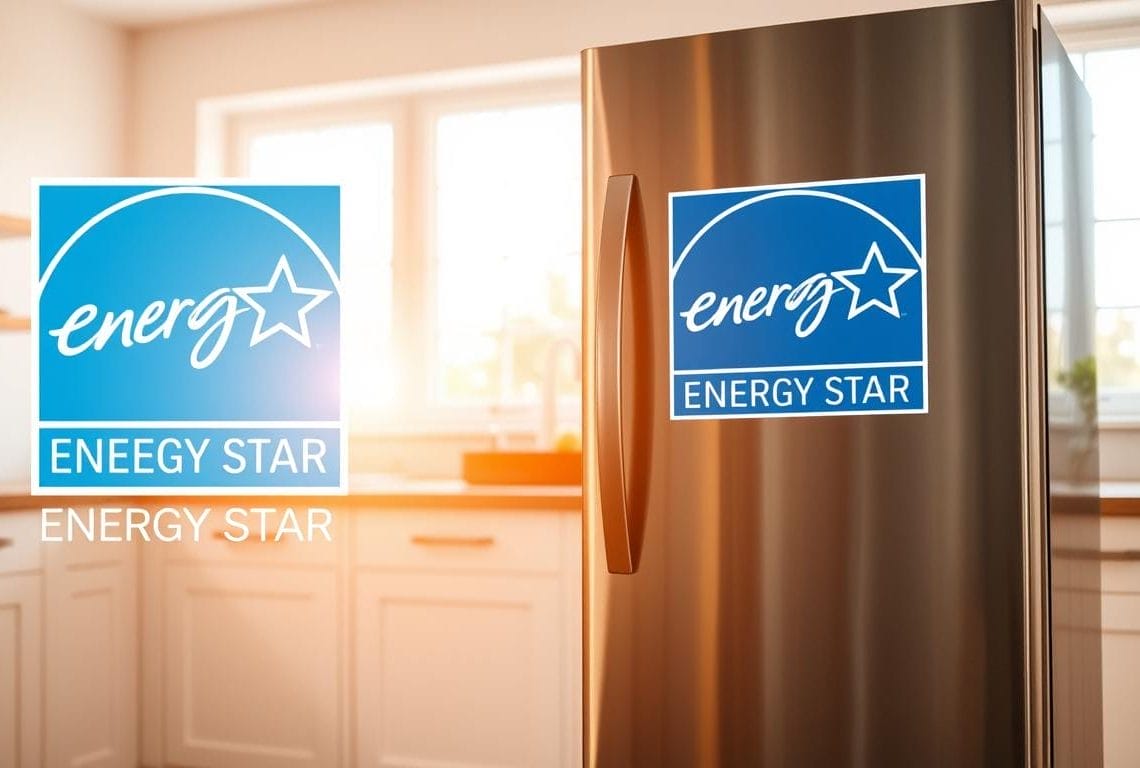
ENERGY STAR certified models and lower energy consumption
ENERGY STAR certified LG and Samsung models exceed federal standards and use less electricity than standard units. That translates to steady savings on monthly bills and smaller environmental impact.
AI Energy modes and monitoring to save up to 10%
AI-driven tools such as Samsung SmartThings Energy learn usage patterns and adjust compressor speed and defrost cycles. This optimization can reduce fridge energy use by up to 10% while maintaining safe temperatures.
- Choose ENERGY STAR: certified refrigerators use less electricity than standard models and lower utility costs.
- Use AI Energy tools: SmartThings Energy can trim up to 10% by learning patterns and optimizing cycles.
- Monitor usage: app dashboards show daily and monthly consumption to spot spikes.
- Optimize settings: set temps to recommended ranges to balance freshness, air flow, and efficiency.
- Maintain gaskets: tight seals prevent cold air loss and reduce compressor run time.
Extra notes: many new models use R600a refrigerant and include inverter compressors, LED lighting, and multi-zone cooling to boost efficiency. Check local rebates for ENERGY STAR products to reduce upfront cost.
Smart features that add everyday convenience
Modern smart features turn a kitchen appliance into a connected command center for daily life. Owners get control, alerts, and actionable information that save time and reduce food waste.

Remote control and monitoring: LG ThinQ lets users change temperature, manage a water filter), toggle ice production, and view energy trends from a phone. Samsung pairs app control with SmartThings for diagnostics and quick fixes.
ThinQ app controls, filter alerts, and energy tracking
Use the app to adjust temps, run diagnostics, and receive a reminder when the water filter needs replacement. Energy dashboards show daily use so owners can optimize settings and enable AI Energy modes.
Family Hub+ screens, SmartThings notifications, and cameras
The 32″ Family Hub+ screen functions as a kitchen hub—calendars, recipes, and media in one place. Internal cameras (AI Vision Inside) let users peek inside without opening the door and help build grocery lists.
Smart cooling systems that help keep food fresher longer
Triple Cooling and Smart Cooling systems balance air flow and humidity across zones. That steady environment preserves produce, deli items, and other perishable product longer.
- Control from your phone: temps, diagnostics, and ice settings.
- Stay informed: door alerts, temp drift warnings, and filter prompts.
- See inside: cameras identify foods and support list creation.
- Track energy: app graphs plus AI modes to reduce consumption.
- Streamline service: remote diagnostics speed repairs and protect stored goods.
Ice, water, and filtration: what to know before you buy
Deciding on ice and water options means balancing convenience, capacity, and maintenance costs. Choose a product that fits daily habits — quick drinks, weekend parties, or athletic households.
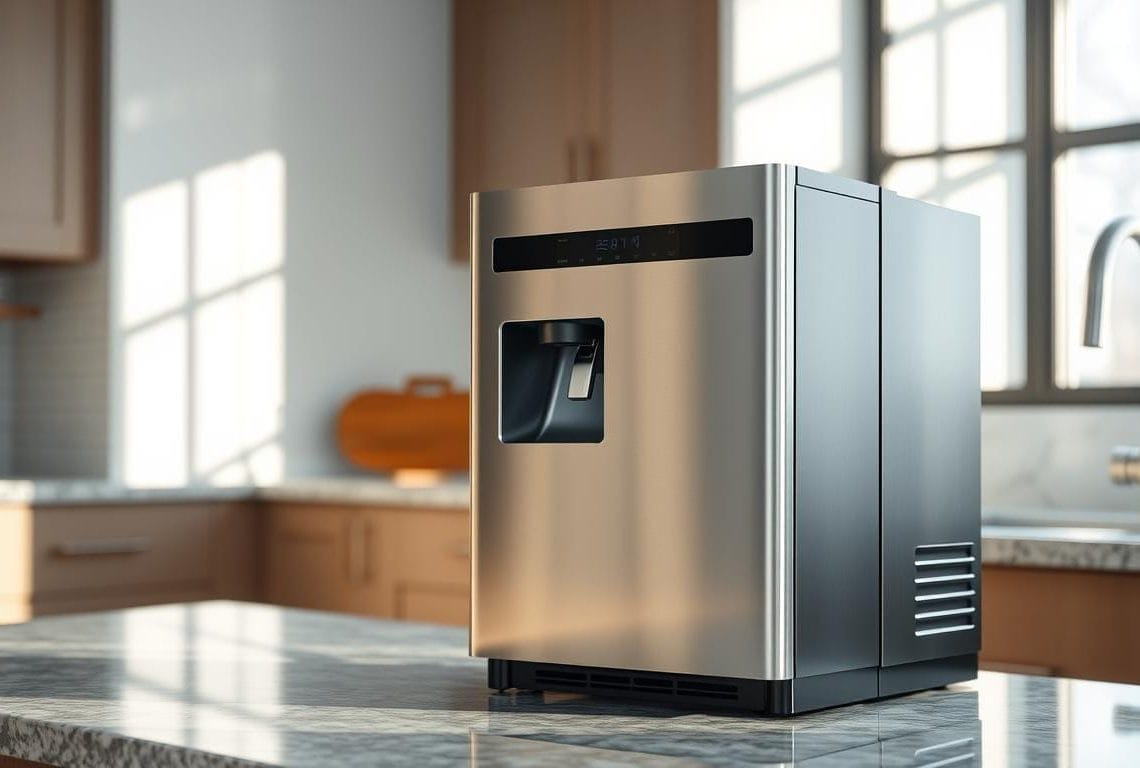
Built-in and dual ice choices
Dual systems deliver cubed ice and Ice Bites for cocktails, smoothies, or fast cooling. The Samsung Dual Auto Ice Maker is an example — it can make about 5.1 lbs/day and store up to 9.0 lbs on select models.
Dispenser styles and AutoFill pitchers
Internal dispensers keep the exterior clean while external units give one-touch access at the door. Some models include AutoFill pitchers that top off automatically from the filtered line — handy for busy families and athletes.
Filters, replacement cadence, and installation
- Know your filter: model numbers like HAF-QIN/EXP help you plan replacements and costs.
- Verify purity: certified filters reduce chlorine taste and particulates; replace per manufacturer cadence.
- Account for space: large ice bins reduce freezer usable volume — check cu. ft. trade-offs before you buy.
- Plan plumbing: ensure an accessible water line and shutoff valve for installation and service.
- Use reminders: app alerts and on-door indicators stop lapses that affect taste and flow rate.
Organization and storage features that really matter
Well-planned interior layouts keep food visible, accessible, and fresher longer. Look for features that match your weekly routine so you can quickly store, find, and use groceries.

Adjustable shelves, slide-in designs, and door bins
Slide-in and foldable shelves create vertical room for tall bottles and pitchers. Gallon door bins free shelf space and keep milk or juice within easy reach.
- Move shelves on the fly to fit party trays or tall containers.
- Use door bins to store everyday liquids and clear shelf real estate.
- Check interior geometry—not just cu. ft.—to see how items actually fit.
Temperature-controlled drawers and multi-zone cooling
FlexZone compartments offer presets for meat, fish, and produce that extend shelf life. Independent zones and Triple Cooling stabilize temps and humidity so every shelf stays consistent.
Deodorizing filters and surround air flow for freshness
Built-in deodorizing filters neutralize strong smells from onions and cheese. Surround Air Flow prevents warm spots—avoid blocking rear vents so cool air reaches every bin.
- Assign zones: kids’ snacks, leftovers, and weekly staples for quick access.
- Plan freezer layout for flat freezing and stackable containers when you store bulk buys.
- Bright LED lighting and glass shelves help you spot and rotate items before they expire.
Tip: compare features across refrigerators to choose a product that fits your kitchen and your storage needs—consider how many cu. the interior truly offers and whether the unit will store your weekly haul.
Brand spotlight: LG stainless steel refrigerators
From counter-depth designs to roomy french door units, LG offers solutions that match real household habits.
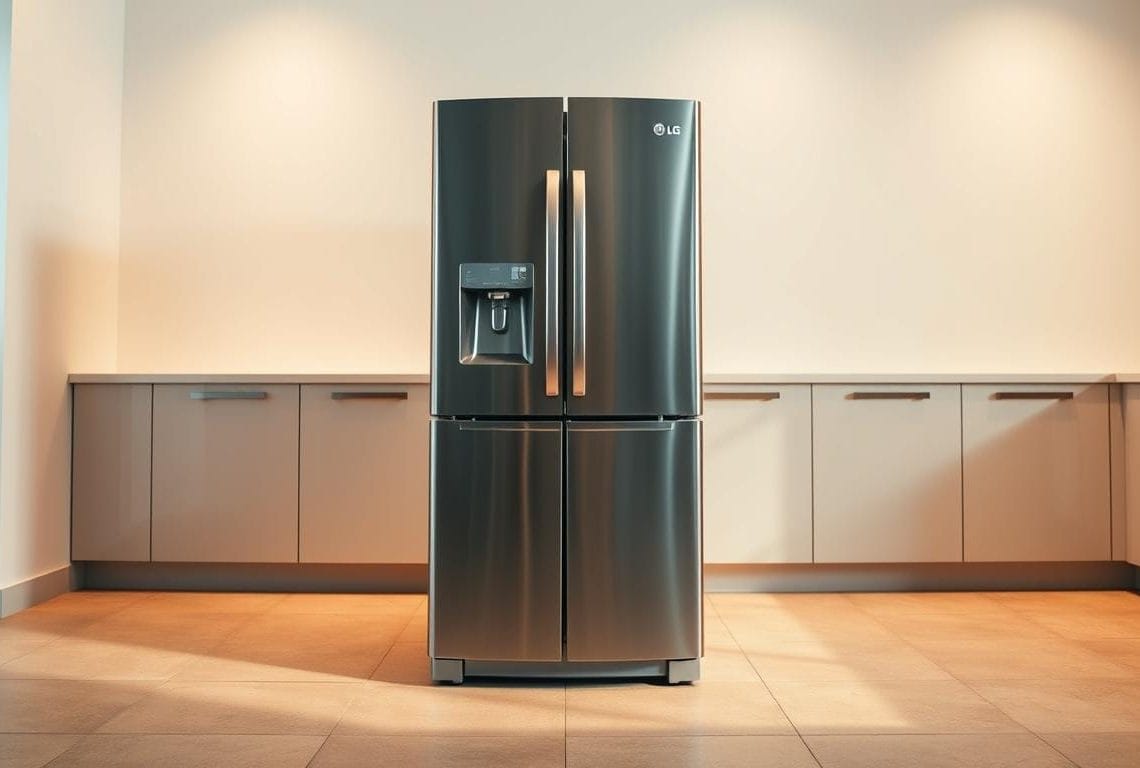
LG’s lineup includes 3- and 4-door french door, side-by-side and counter-depth options that fit kitchens of all sizes. These refrigerators aim to blend usable capacity with smart controls.
French door, side-by-side, and counter-depth models
Explore models that put fresh food at eye level or maximize freezer access with a side configuration. Choose a door refrigerator layout to match traffic flow and pantry habits.
PrintProof finish, Craft Ice, and large capacity
PrintProof keeps exteriors cleaner with less wiping. Craft Ice produces slow-melt spheres that elevate drinks and preserve flavor.
Many LG options start at 24+ cu. ft. (often listed as cu.) for shoppers who stock weekly groceries or entertain often.
Why LG: reliability, ENERGY STAR, and ThinQ smart tech
Energy star certified models cut operating costs. The ThinQ app lets owners monitor energy trends, get filter alerts, and adjust temps remotely.
As a maker with strong ratings, LG emphasizes reliability and customer satisfaction—so buyers compare features before they pick a product or model.
Want a practical appliance that balances tech and service? LG remains a solid choice for households seeking capacity, smart control, and low-maintenance finishes.
Brand spotlight: Samsung Bespoke and Family Hub refrigerators
Samsung blends bold customization with advanced AI to make a fridge that fits modern home life. The Bespoke series offers flat doors and swap‑out panels in 11 colors and two finishes so owners can change kitchen color without replacing the entire appliance.
Custom panels and flat-door styling
Personalize the look: changeable panels let you update a kitchen’s palette. The flat-door design reads as modern and reduces projection into walkways. Select models offer up to 29 cu. ft. within a 35.875″ W x 73″ H footprint—verify depth for cabinet fit.
AI Family Hub+, AI Vision Inside, and smart energy
Control and visibility: the 32″ Family Hub+ screen centralizes recipes, calendars, and streaming. AI Vision Inside identifies select produce and sends open‑door or filter alerts. SmartThings Energy with AI Energy mode can cut use by up to 10% while reporting energy info in the app.
Ice, beverage, and freshness features
Convenience built in: Dual Auto Ice Maker supplies cubed and Ice Bites. A Beverage Center and internal water dispenser speed drink prep. Triple Cooling, a deodorizing filter, adjustable shelves, gallon bins, and a FlexZone compartment keep storage organized and air balanced.
- Warranty & trust: ENERGY STAR models and a 10-year digital inverter compressor warranty.
- Purchase support: financing, delivery options, and select in‑home trials for customer confidence.
- Why it matters: this maker packs style, smart controls, and practical storage into one product.
Installation, delivery, and service details to plan ahead
A smooth installation begins long before the truck arrives—measure, reserve access, and confirm services.
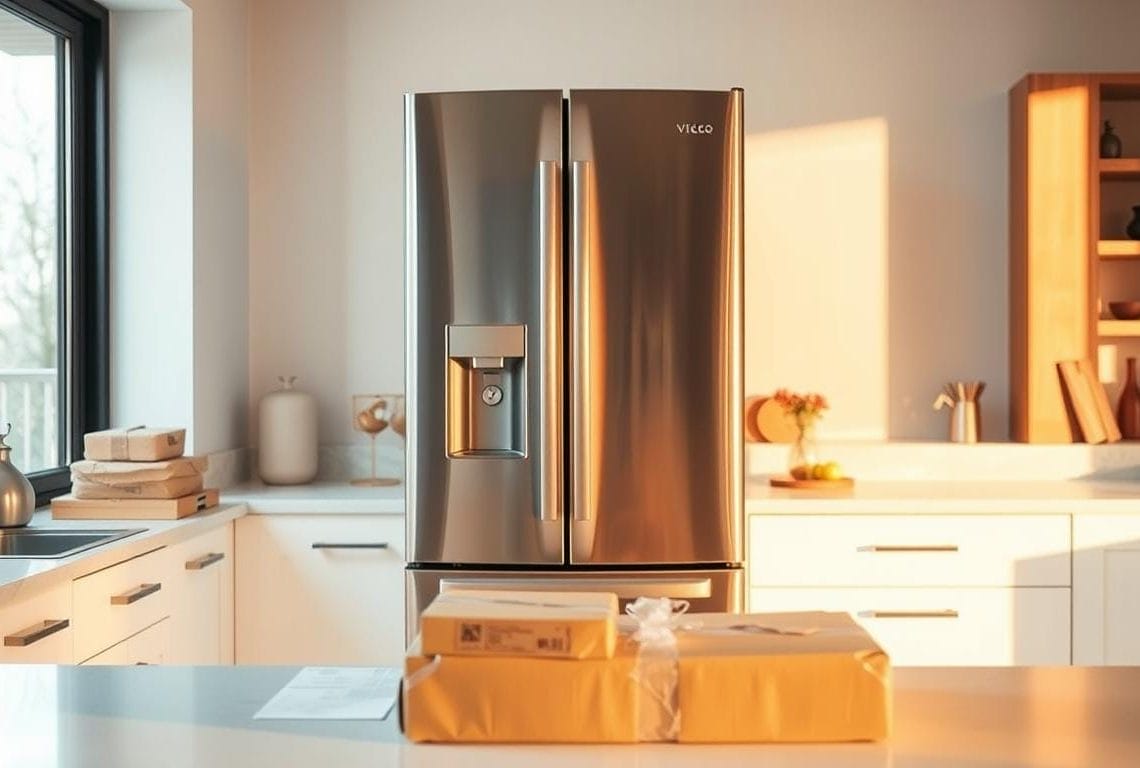
Scheduling delivery, professional installation, and setup
Lock in delivery windows early. Coordinate building access, elevator reservations, and parking to avoid missed appointments.
Many brands offer scheduled delivery and next-day installation in select areas. Choose pro installation so the water line, voltage, and level are verified and ice/water functions are tested before the team leaves.
Measuring guides, counter-depth vs full-depth fit, and door removal
Confirm counter-depth or full-depth before you order and review spec sheets for hinge and handle clearances.
Measure doorways, halls, and stairs against shipping dimensions; request door removal service if clearances are tight. Inspect the fridge on arrival—check for cosmetic damage, aligned doors, and smooth drawer action.
Warranty tiers and service experience expectations
Gather model numbers, serials, and installation information for warranty registration and future service.
- Understand typical tiers: 1-year parts & labor, multi-year sealed-system coverage, and 10-year compressor parts (with defined labor terms).
- Test smart setup: connect Wi‑Fi, register the product, and enable alerts for open door, temperature, and filter events.
- Plan haul-away and recycling to free space and avoid extra trips.
Tip: Save authorized service contacts and app links so customer support can resolve issues quickly after delivery.
Price, promotions, and payment options
Smart shopping starts by matching advertised discounts to the features you actually need.
Comparing prices by capacity, features, and models
Line up prices against capacity, layout, and smart features. Focus on real value—not just a promo headline.
Compare side-by-side: tally capacity, warranties, and energy tech to see which product saves most over time.
Store offers, credit and financing, and bundle deals
Watch promo calendars. Samsung and others list 0% APR credit for up to 24 months, next-day delivery in select areas, and bundle-and-save events. Promotions and pricing can change before shipment—read the terms of sale.
- Use 0% credit windows only when monthly payments fit your budget.
- Factor delivery, installation, haul-away, water kits, and filters into final prices.
- Confirm store policies: price protection, return windows, and restocking fees before you order.
- Consider warranty add-ons and service plans for heavy-use homes.
Tip: stack eligible bundle savings with card offers when allowed. Keep invoices and promo confirmations for any customer or rebate claims. To review a specific model before you order, see this option from GE Appliances: order and compare this model.
Maintenance and cleaning to extend the life of your appliance
Regular maintenance keeps a high-performing appliance running longer and prevents costly repairs. A short, seasonal routine protects finishes, cooling systems, and smart features so the unit stays reliable.
Care for smudge-resistant finishes
Use microfiber and non-abrasive cleaners. Wipe with the grain to preserve LG’s PrintProof and Samsung’s fingerprint-resistant coatings.
Gentle, frequent cleaning maintains the finish and reduces the need for heavy scrubs that can dull the surface.
Replace water filters and clean shelves
Follow app reminders and replace the water filter on schedule to keep taste, flow, and ice clarity strong.
Handwash bins and glass shelves with mild soap; dry fully to prevent odors and protect seals and glide tracks.
Keep air flow, coils, gaskets, and software up to date
Refresh deodorizing filters and keep vents clear so surround air flow stays even. Vacuum coils and the toe-kick to improve heat exchange.
Inspect door gaskets for tears and clean them gently to preserve a tight seal.
Smart upkeep and routine checks
- Update ThinQ or SmartThings apps and install firmware updates for stability.
- Run diagnostics after outages or moves using app tools.
- Set calendar reminders for filter swaps, deep cleans, and seasonal inspections.
Tip: small, regular tasks reduce energy use, preserve performance, and lengthen service life for household appliances.
Your next step to the right stainless steel refrigerator
Your next step: match the unit’s specs to your kitchen, delivery path, and daily routine before you order.
Measure twice: confirm width, height, depth, ventilation, and door swing. Review Samsung and LG spec sheets and buying guides online to verify shipping dimensions and whether door removal may be needed for tight halls.
Decide depth — counter-depth for a built-in look or full-depth for maximum capacity. Prioritize features: dual ice, internal water, temperature drawers, and ThinQ or SmartThings app control.
Plan installation and delivery: schedule professional installation, confirm access, and book a slot for any required door removal. Check warranty tiers, local authorized service, and customer support options to protect your purchase.
Finalize budget and finish: compare prices, financing and bundle promos, choose PrintProof or fingerprint-resistant finishes, then register the refrigerator and connect apps. Start strong—install the first water filter, calibrate temps, and organize shelves for your home routine.






